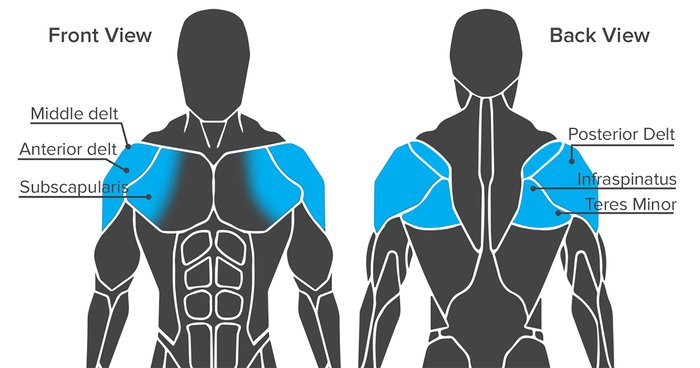Muscle Growth | Arms | Legs | Back | Chest | Shoulders | Core
Broad, developed shoulders are one of the fundamentals of a physique that says, ”Yes, I lift.” But shoulder pain and dysfunction are also incredibly widespread among lifters and can impact everything else you do. Even leg training can be a chore if your shoulders hurt.
Knowing the anatomy and function of your shoulders can help you train safely and grow more quickly. Here’s what you need to know to build your strongest, safest shoulders.
Muscular Anatomy of the Shoulders
One of the best ways to think about your shoulder muscles is in layers. The first layer of muscle around your shoulder joint is called the deltoid, which is made of three separated ”heads.”
All three heads of your delts work together for most movements. For example, any time you lift your arm overhead—like you would for an overhead press—all three of your deltoid heads move synergistically. You can also isolate each head once you know their specific movements.

Deltoid Anterior Head: Located on the front of your shoulder, the anterior head originates on the front of the clavicle, runs down and across, and attaches to your upper arm. The anterior delt powers shoulder flexion, which is raising your arm in front of your body as you would during a front raise.
Middle Head: This muscle lies just behind the anterior head. It begins at the top of your scapula, or the acromion process, and attaches to the outer portion of the upper arm. Your middle or lateral delts also help with shoulder flexion, but they are the primary muscle responsible for shoulder abduction, or when you bring your arms away laterally from the midline of your body, as in a lateral raise.
Posterior Head: The posterior head originates on the back of the scapula along the scapular spine and attaches to the back of the upper arm. Your posterior delts contribute heavily to shoulder extension, or when you bring your arm behind your torso either out to the side or with your hand pointed downward.
Take care of your joints so they’ll keep supporting you every shoulder day—and every day, period!
Rotator Cuff
If you peeled away the deltoids, underneath them you would find a deep layer called the rotator cuff. Your rotator cuff consists of four muscles which create stability, aka keeping your humerus squarely in the shoulder joint. It also contributes to internal and external rotation of your humerus, which is why lifters often do external rotations as a warm-up on chest or shoulder day.
- Infraspinatus: The infraspinatus is the big muscle that spans the outside portion of your scapula.
- Teres Minor: Under the infraspinatus is a smaller muscle called the teres minor.
- Supraspinatus: This muscle runs from the scapula and attaches to the inside of the humerus.
- Subscapularis: The subscapularis muscle sits on the front of the shoulder blade.
Essential Muscle-Building Shoulder Exercises
Here are some great exercises to help you develop those shoulders and keep your joints healthy and mobile. Your shoulders get a workout doing big, compound movements like the overhead and bench press, but a little extra isolation work—particularly on the rear deltoids—can help them get bigger and healthier.
Here are two essential exercises for full shoulder development. You’ll find both—and several others—in the full shoulder workouts each Friday of the Built by Science: 6-Week Muscle-Building Trainer.
This movement uses all three heads of your deltoid muscle and is a great exercise for lifting heavy with the shoulders that can be done standing or seated. If your shoulders don’t seem to like performing the movement with your elbows straight out to the side and palms facing forward, it doesn’t mean pressing isn’t for you. Instead, try it with your palms facing in and your elbows slightly forward.
The posterior delt gets some work in presses, but it almost always needs some isolation work as well. A great choice is any variation of a reverse fly, also known as a bent-over fly or rear delt raise. You can perform it seated or standing, using dumbbells, cables, bands, or even small weight plates.
Too often, people do this movement with excess momentum. Slow down and use your muscles to move the weight under strict control. If you can’t, it’s a sign that you need to reduce the weight.
Take the time to warm up before you go through the workouts. If your shoulder muscles are weak, go lighter and do the exercises correctly. You’ll get more out of the exercise that way.
Build the body you want by learning how to train every muscle group and the best exercises to help you reach your goals!
